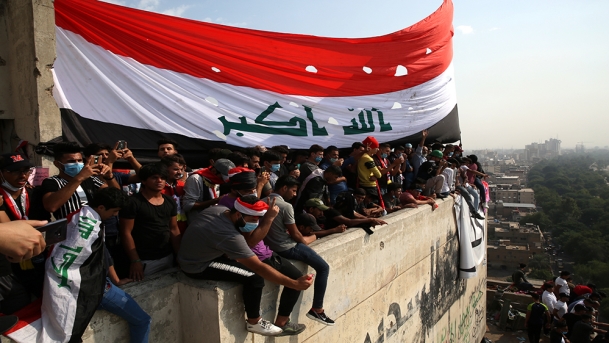
As the demonstrations in Iraq intensify to levels unseen since the 2003 US invasion, the Iraqi government has been forced to grapple with a new kind of protest movement led primarily by youth and unaffiliated with any single religious, social, or political current.
The protests, which began in early October, represent a popular rejection of the policies pursued by all Iraqi governments since 2003, which the protestors say have impoverished Iraqis, fomented ethnic and sectarian divisions, and led to rampant corruption. Despite considerable oil wealth, poverty and unemployment remain pressing social issues, particularly for youth and in less urban areas. The protestors ascribe this dysfunction to the corruption and mismanagement of all post-2003 governments, as well as to a sectarian political system under which the country’s wealth is divided among the forces and figures that have dominated the political landscape since 2003. They have also linked many of the country’s endemic problems to Iranian interference.
Given their diagnosis of the country’s ills, protestors are demanding wholesale political change: the dissolution of parliament, the resignation of the government, changes to the constitution, and early elections with international and judicial supervision. Many demonstrators have also demanded that the entire established political class be banned from candidacy in coming elections.
The authorities have largely responded by trying to appease demonstrators with promises of reforms, affirmations of sympathy with their demands, and pledges to crack down on corruption, but they have ruled out the resignation of the government, arguing that it would leave a power vacuum and paralyse state institutions.
Despite the government’s stated concern for the safety of protestors and its refusal to use force against them, the security response has been violent. At least 250 people have been killed and more than 10,000 injured, including by snipers in the early days of the protests. While the authorities have admitted that excessive force has been used in some cases, they have not identified the party responsible for using snipers.
Thus far, the Iraqi political authorities have not proved able to quell the demonstrations with promises of reform. Given the lack of trust between the government and protestors, a compromise currently looks unfeasible and the protests will likely continue and perhaps escalate. This will put additional pressure on the Iraqi security and military apparatus, but it will likely maintain its cohesion, which in turn militates against any radical change in the structure of the regime.
In the long term, the damage the protests have inflicted on Iran’s standing may undercut the popularity of its allies in the country and foster the emergence of an Iraqi patriotism that rejects all foreign influence and sectarian divisions.
In the near term, the current political system will likely endure without fundamental change. Despite the impressive turnout in the protests, a considerable number of Iraqis have a stake in the status quo, from political parties to religious and tribal formations to those like civil servants who enjoy relative security under the current system. While this societal division may not be apparent now, this class could be mobilised to stave off radical changes to the current system. Outside powers, too, have a stake in the status quo, particularly Iran, with its multiple allied Iraqi political and paramilitary factions.
For the time being, the authorities seem to be waiting out the protests, relying on the coming winter or public dissatisfaction with the disruptions to daily life to thin their numbers and make protestors more amenable to persuasion. A more severe security response is also a possibility, particularly if the protests escalate, but this action could spark international condemnation and perhaps even outside intervention. Moreover, a security crackdown could encourage protestors themselves to take up violence. While some forces in and out of Iraq may encourage this trend, it is an unlikely scenario given Iraqis’ still vivid memory of the horrors of the post-2003 civil war and the fight against the Islamic State. In addition, both Iran and US have a common interest in preventing the situation from spiraling out of control, assessing that this would be a boon to armed jihadi groups, especially the Islamic State.
*This is a summary of a policy brief originally written in Arabic, available here: http://studies.aljazeera.net/ar/positionestimate/2019/11/191107140332263.html